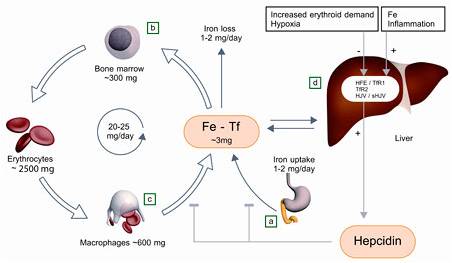Background
Hepcidin is a 25-amino acid peptide hormone that is the central regulator of body iron metabolism. It is synthesized in the liver (d) and secreted in plasma and binds to the cellular iron export channel ferroportin causing its internalization and degradation, thereby decreasing iron efflux from iron exporting enterocytes (a) and macrophages (c) into plasma.

Increased iron stores and inflammation induce hepcidin synthesis, whereas suppression occurs during hypoxia, anemia and increased and/or ineffective erythropoiesis in the bone marrow (b). Furthermore, hepcidin deficiency plays a central role in the iron loading in hereditary hemochromatosis and thalassemia’s. Finally, hepcidin is induced under conditions of infection, decreasing the available host iron pool that is essential for survival of invading pathogens.
Most of the evidence on hepcidin regulation and mode of action comes from in vitro work and mice studies that often use hepcidin mRNA as a read out. Until recently, human studies were largely impeded because suitable hepcidin assays were not available. Thus, although these discoveries on the regulation and mode of action of hepcidin have had wide reaching effects throughout the field, much work remains in defining the role of hepcidin in both healthy and diseased states.
